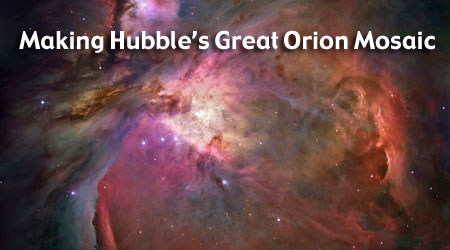Podcast: Making Hubble’s Great Orion Mosaic
- By Maggie Masetti
- August 14, 2009
- Comments Off on Podcast: Making Hubble’s Great Orion Mosaic

Click to listen! (7.5MB MP3, right-click to save)
Transcript (Text, PDF)
The Hubble Space Telescope is famous for its beautiful images of celestial objects – from planets in our own Solar System to far away galaxies. The Orion Nebula (known to astronomers as Messier object 42, or M42) is a cloud of dust, gas, and stars. It’s actually visible with the naked eye, located in the “sword” of the constellation Orion. The nebula contains both an open cluster of stars known as the Trapezium, and many stellar nurseries. Because of this, it’s of interest to scientists who want to learn more about how stars are born. And we don’t mean the kind out in Hollywood! (We know, that’s a terrible joke.)
Astronomer Massimo Roberto from the Space Telescope Science Institute has dedicated a lot of his research to the Orion Nebula, and he talked to us about the creation of a breathtaking mosaic of it made with data from the Hubble Space Telescope.
About the Episode
The Hubble Space Telescope has produced many gorgeous images. Here we’ve linked to the image of the Orion Nebula featured in this podcast, as well as the online gallery of other Hubble images. Hubble’s successor, the James Webb Space Telescope, planned for a 2014 launch, will continue to help us to better understand the Universe. Stay tuned in 2010 for that IMAX fly-through of the Orion Nebula!
| Host | Maggie Masetti |
| Interviewer | Francis Reddy |
| Guest | Massimo Roberto |
| Editors | Francis Reddy Maggie Masetti Sara Mitchell |
| Theme Music | Naked Singularity |
| Additional Music | Kevin MacLeod |
| Transcript | Maggie Masetti Francis Reddy |
| Website Support | Meredith Gibb Maggie Masetti |
| Producer | Sara Mitchell |
| Executive Producer | Anita Krishnamurthi |
| Responsible NASA Official | Kim Weaver |


